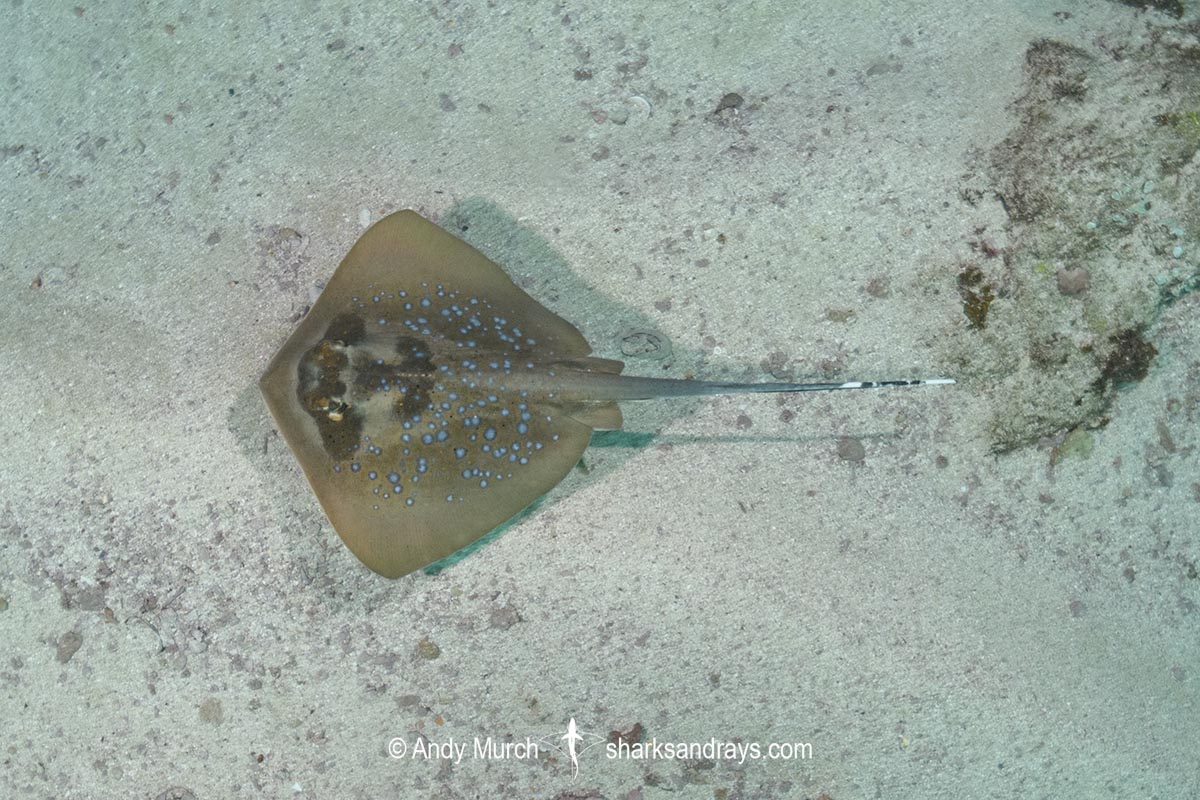Common name(s)
Indian Ocean Bluespotted Maskray.
Identification
A small stingray with a kite-shaped disc that is wider than long. Snout short and bluntly angular. Tip of snout not extended. Anterior margins of disc weakly convex. Pectoral fin apices angular and slightly falcate. Pelvic fins large; apices narrowly rounded.
Eyes large and protruding. Snout length greater than combined eye and spiracle length.
Mouth small. Prominent labial furrows and folds around mouth. Nasal curtain narrow and skirt-shaped; posterior margin undulate and fringed. Nostrils thin.
Tail broad and depressed at base, tapering gently to caudal sting, then thin but firm to tip. No prickly denticles on tail. Tail length (when intact) to at least 1.5 x disc width. Ventral finfold long and low. Dorsal finfold very short. 1 or more tail stings usually present.
Colour
Dorsum brown with a dark brown band across eyes, and numerous eye-sized blue spots (often with pale centres), and scattered very small black specs. Blue spots mostly absent near disc margin. In the southwest African population of N. indica, a dark triangular blotch extends backwards to nape, joining a second dark band between the shoulders. Ventrum pale. Tail bluish grey dorsally, with irregular black and white bands beyond the dorsal finfold. Caudal finfolds bluish-grey with a black margin.
Size
Maximum disc width unknown.
Habitat
Tropical/subtropical seas. On sandy substrates, often adjacent to reefs. From shallow bays to at least 15m (personal observation). Max depth unknown.
Distribution
Western Indian Ocean. Described from specimens collected in India and Tanzania. Presumably, any bluespotted rays occuring to the west of India, southward to South Africa would most likely be this species. However, further study is needed to establish the western limit of the more easterly Bluespotted Maskray – Neotrygon caeruleopunctata.
Conservation Status
NOT EVALUATED
The Indian Ocean Bluespotted Maskray is part of a recently split complex of rays that were previously grouped as Dasyatis kuhlii. This member of the Kuhlii complex has not yet been assessed by the IUCN.
Citation
Last, P.R., White, W.T. and B. Séret, 2016. Taxonomic status of maskrays of the Neotrygon kuhlii species complex (Myliobatoidei: Dasyatidae) with the description of three new species from the Indo-West Pacific. Zootaxa 4083(4):533-561. (Ref. 116741)
Reproduction
Aplacental viviparous. Litter size unknown.
Diet
Diet unknown.
Behavior
Sedentary. Behavior poorly known.
All Indian Ocean Bluespotted Maskrays in Sodwana Bay, South Africa were found (near reef structure) deeply buried under sand, during the day (personal observation).
Reaction to divers
Extremely shy and difficult to approach. May remain still while deeply buried, but bolts immediately (either across sand or under a nearby ledge) if the sand concealing it is even slightly disturbed.
Diving logistics
Indian Ocean Bluespotted Maskrays are probably found from India to South Africa; see distribution note. They appear to be encountered quite often at numerous diving destinations on the western side of the Indian Ocean.
At the southern tip of their range, they are relatively abundant at dive sites in Sodwana Bay, South Africa. At some sites on Two Mile Reef, I encountered up to eight individuals on a single dive.
What’s new
View our full list of updates
Similar species
Bluespotted Maskray A very similar ray. Distinguishable by lack of second dark band across shoulders, and by more easterly range in the Indian Ocean.





